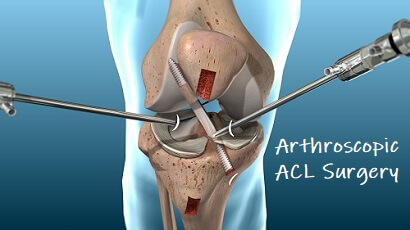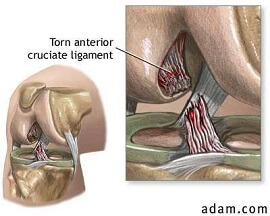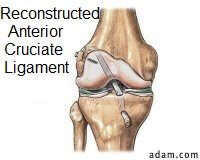Arthroscopic ACL Reconstruction
The anterior cruciate ligament (ACL) is a three to four-centimeter long band of fibrous tissue that connects the femur (thigh bone) to the tibia (shin bone). It helps stabilize the knee joint when performing twisting actions. The cruciate ligament is essential in controlling the rotation of the knee during side stepping, pivoting and landing from a jump.
An ACL injury often occurs in sports, but it can also occur if you twist your knee suddenly or receive a direct hit to the knee. Injury to your ACL is often accompanied by a "popping" noise and the feeling that your knee could give out from under you.
While swelling and pain may go away on its own, if you have an ACL injury and you return to sports, your knee may be unstable and you risk causing further damage to the cushioning cartilage (meniscus) of your knee.


What Is An ACL Injury?
Arthroscopic ACL surgery is indicated when there is significant damage to the ACL. The ACL (anterior cruciate ligament) is one of a pair of ligaments in the middle of the knee joint, responsible for providing stability.
Here we will look at how the ligament gets damaged, the types of ACL surgery that are done, how to decide whether you need surgery and what the alternatives are to surgery. To find out more about how the ACL gets damaged, visit the ACL injuries section.
ACL Repair Surgery
Arthroscopic ACL repair surgery is usually done when the ligament has broken off from the bone (known as an avulsion) but is still intact. The ligament is reattached to the bone and held in place.
Repair is sometimes carried out if the ligament has partially torn. The surgeon sews the ligament back together so it can heal. However, there is a high failure rate so in most cases, it is better to go for a reconstruction rather than repair.
All-arthroscopic repair is usually an outpatient procedure and is the least invasive method to repair a torn rotator cuff.
ACL reconstruction is the current standard-of-care surgical treatment for ACL tears. This procedure typically uses a graft, or a piece of tissue, placed in the knee in a minimally invasive surgery that uses small incisions. Most ACL surgeries performed at HSS are ACL reconstructions.


ACL Reconstruction
If there is more significant damage, or there are ongoing problems with pain and instability, the torn ligament is removed and replaced with a graft, usually taken from your hamstring or patellar tendon. This is known as arthroscopic ACL reconstruction surgery.
An ACL reconstruction is much more common than an ACL repair.
You can find out more about what the surgery involves, the recovery process and common problems associated with surgery in the ACL reconstruction section.
ACL reconstruction is the current standard-of-care surgical treatment for ACL tears. This procedure typically uses a graft, or a piece of tissue, placed in the knee in a minimally invasive surgery that uses small incisions. Most ACL surgeries performed at HSS are ACL reconstructions.
